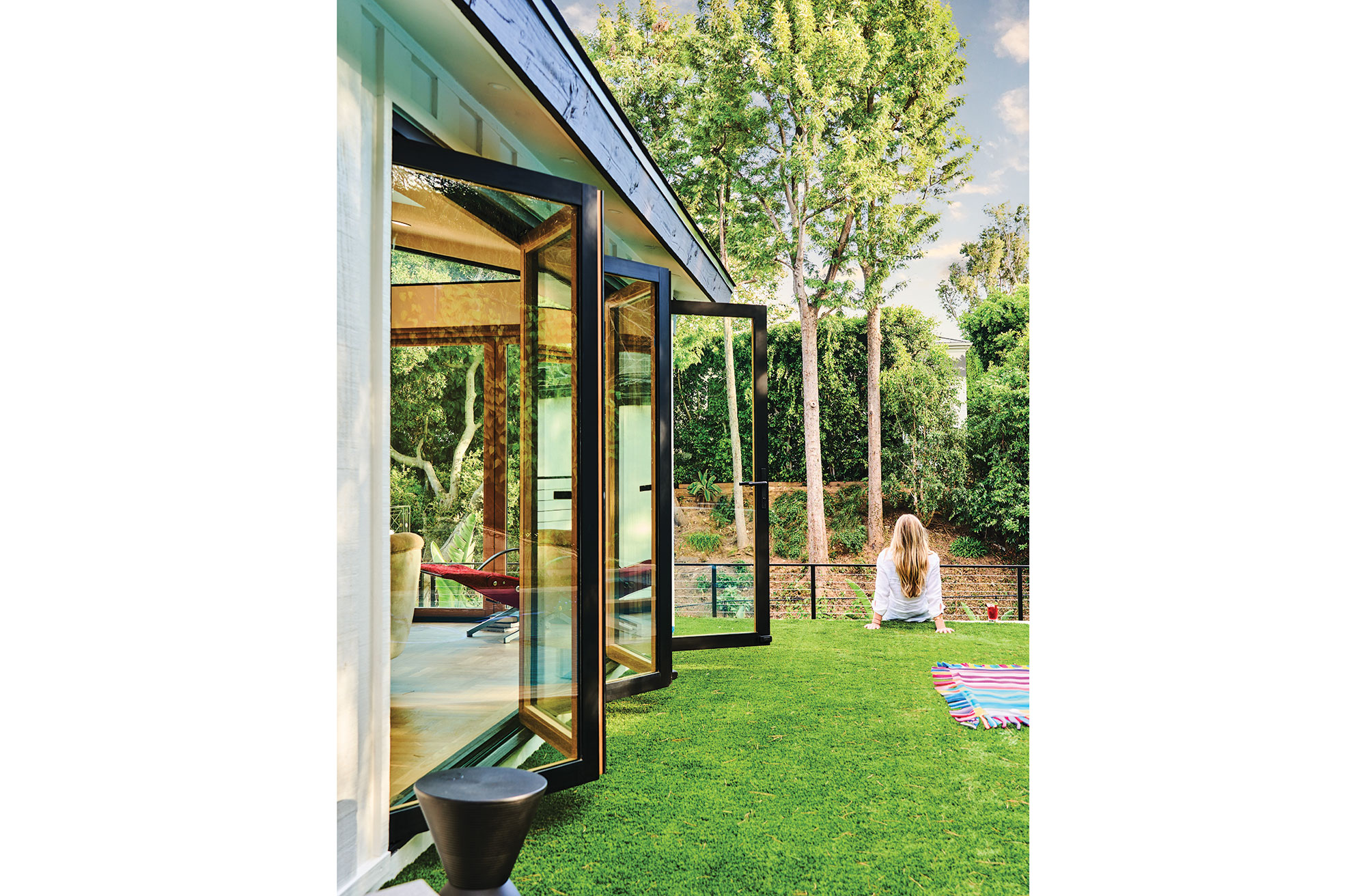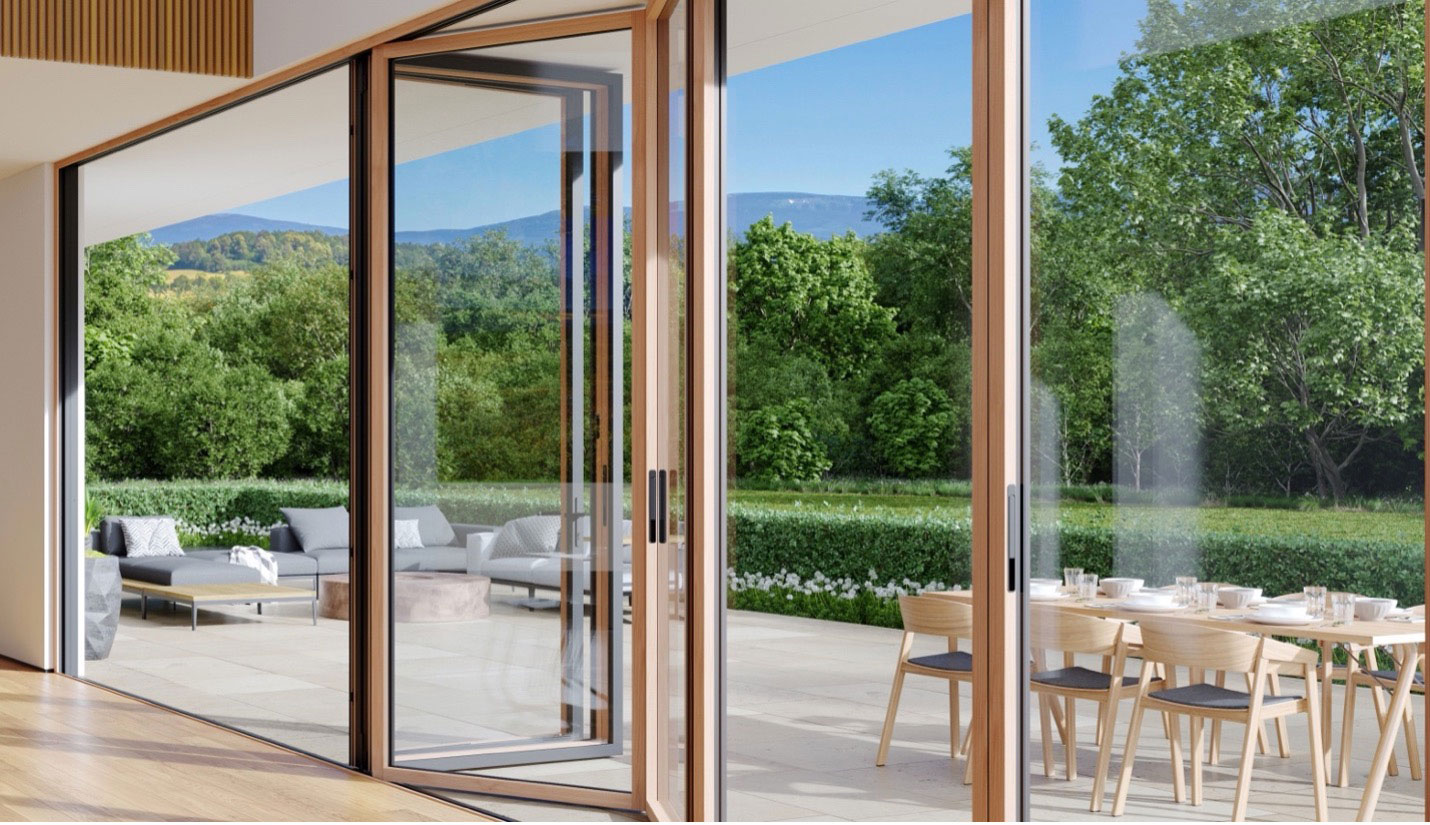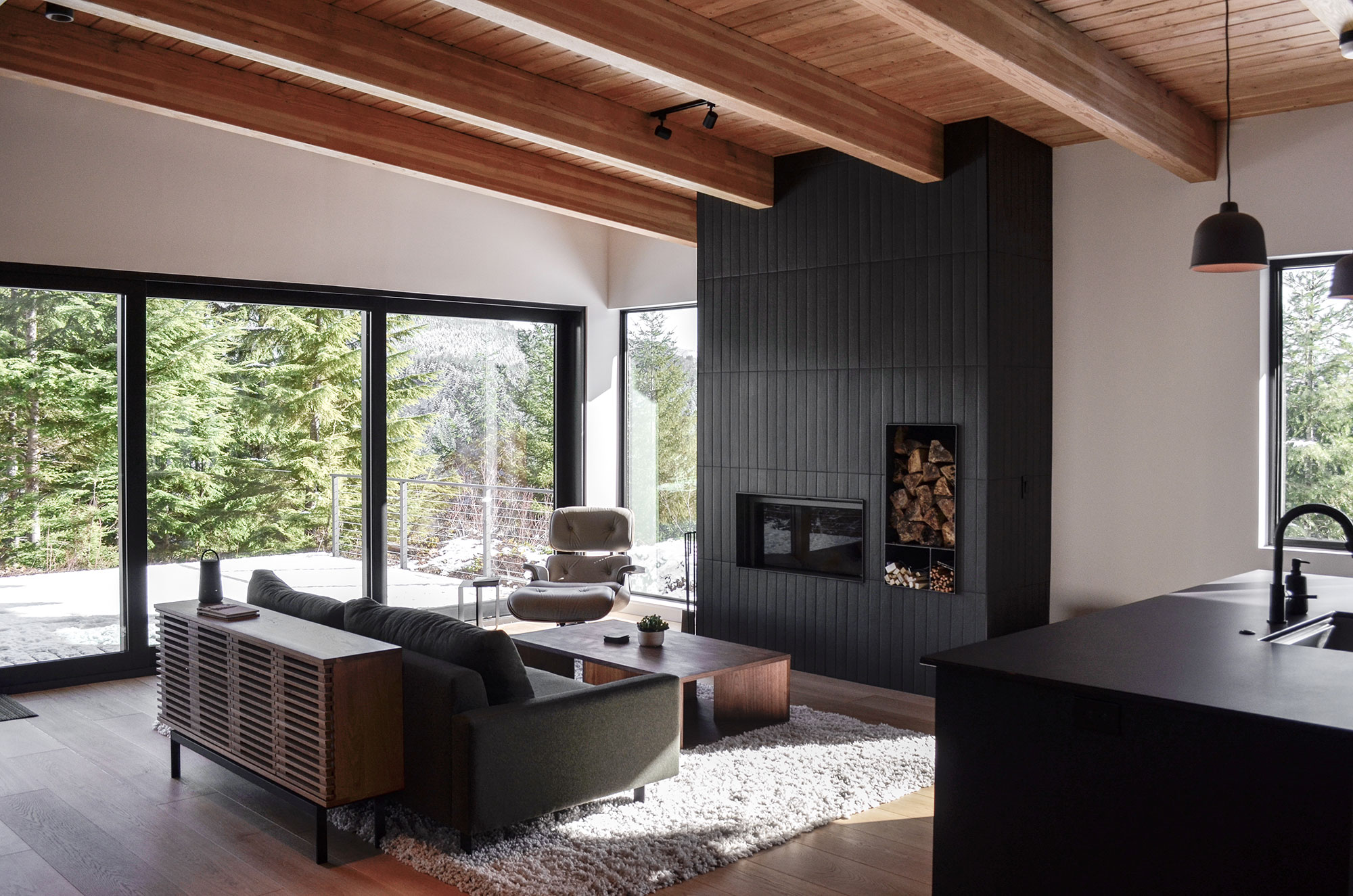Big Doors, Big Dreams
Specifying movable glass door systems to maximize potential in any space
Sponsored by LaCantina Doors | Presented by Amanda Voss, MPP
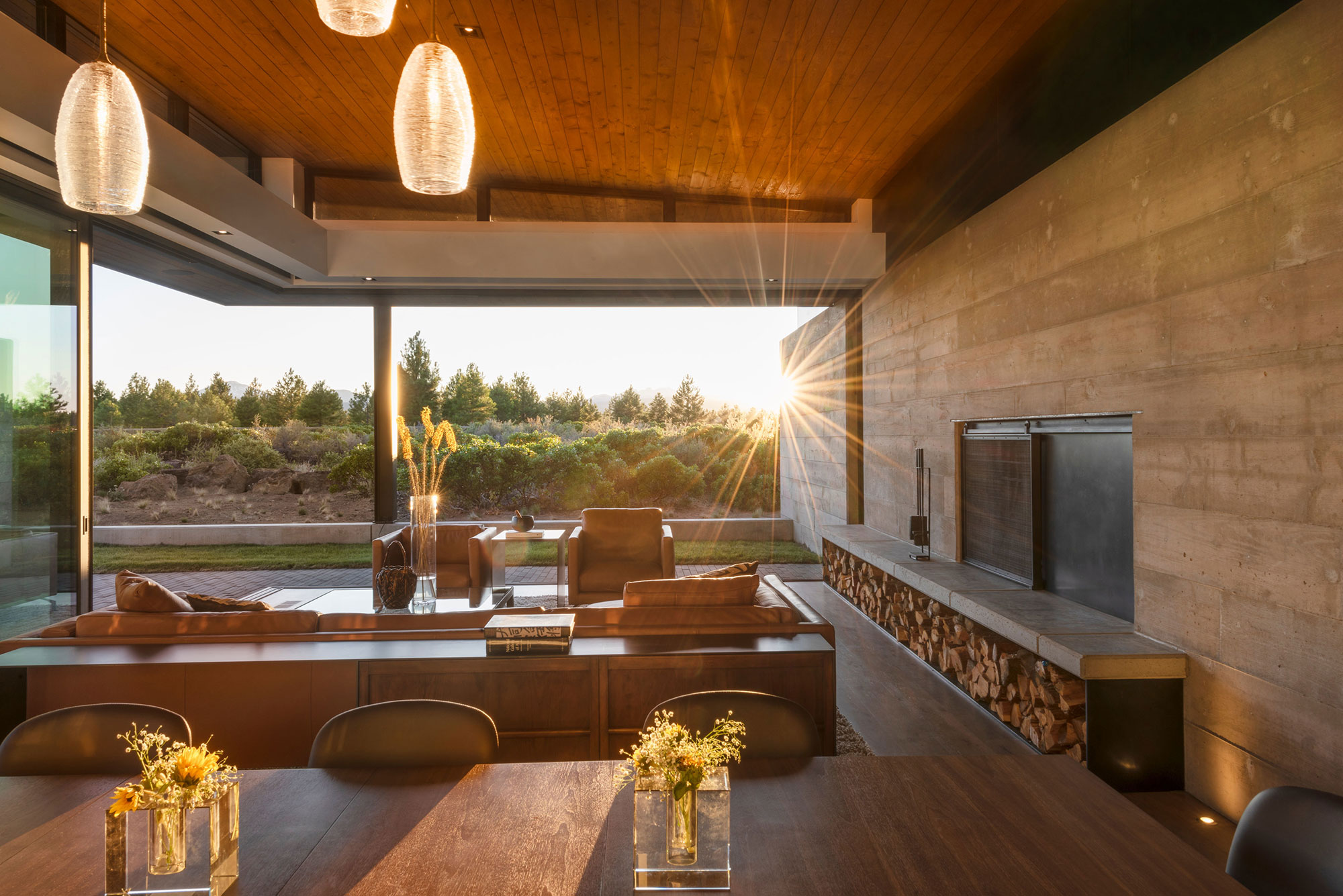
Photo courtesy of LaCantina
Incorporating movable glass door systems allows any home to seamlessly blend with its surroundings, integrating nature directly within the footprint of the residence.
Movable glass panel doors break the boundaries of design conceptions. No longer confined to large, custom spaces, incorporating movable glass panels maximizes living opportunities and occupant health in any space. Low maintenance and uniquely versatile, these systems connect the indoors and outdoors with a streamlined design that works with any type or style of home. The expansive use of glass makes any home a beautiful, welcoming, and modern space. It also places heavy performance demands on that glass and the surrounding frames. As a greater percentage of wall space is occupied by windows and doors in smaller homes, the insulative and performance properties of those products need to be increased, to avoid placing an energy burden on the building. The entire system must also be evaluated on its ability to prevent air leakage, how it will interact with weather events, and how it will stand up to the wear and tear of daily use. This is where energy and performance codes become invaluable. Understanding the certifications for door performance means selecting with confidence a movable glass system that will not only look beautiful, but will perform beautifully over the life of the building.
In tandem with the improved health metrics that movable glass panel door systems can provide, enhancements in manufacturing and technology have increased efficiency. Today, these systems can occupy a greater area in the building envelope without compromising overall performance. The best manufacturers create movable glass panel door systems that are not only visually appealing, but also are built to perform, even in the most severe climates and regions.
Door systems should be developed, designed, tested, and engineered for optimal thermal performance, structural integrity, strength, and protection against the elements. In partnership with their focal aesthetic role, advancements in movable glass panel door systems and component technology allow any design to achieve energy efficiency goals, performance, and service life, creating a project that transcends trends.
Innovations in materials and components allow the units to maintain energy efficiency as well as capture holistic benefits, including increased ventilation and daylighting. Performance testing and certifications provide assurance of product performance and sustainability and offer design professionals an excellent tool for product selection.
ENHANCING OPPORTUNITY
“Start maximising what you have, instead of worrying what you don’t have.” − Tony Curl, Seriously Simple Stuff to Get You Unstuck
The most recent data from the National Association of Home Builders (NAHB) found that the average new home size has dropped: from 2,479 square feet in 2022 to 2,411 square feet in 2023.1 This is the smallest square footage average in 13 years.
With home sizes decreasing, residential trends are rapidly shifting to reflect this change. And the shift in home size is not going anywhere fast. According to NAHB data, 38 percent of builders surveyed are indicating they built smaller homes in 2023 to help support home sales. Twenty-six percent state they plan to build even smaller in 2024.
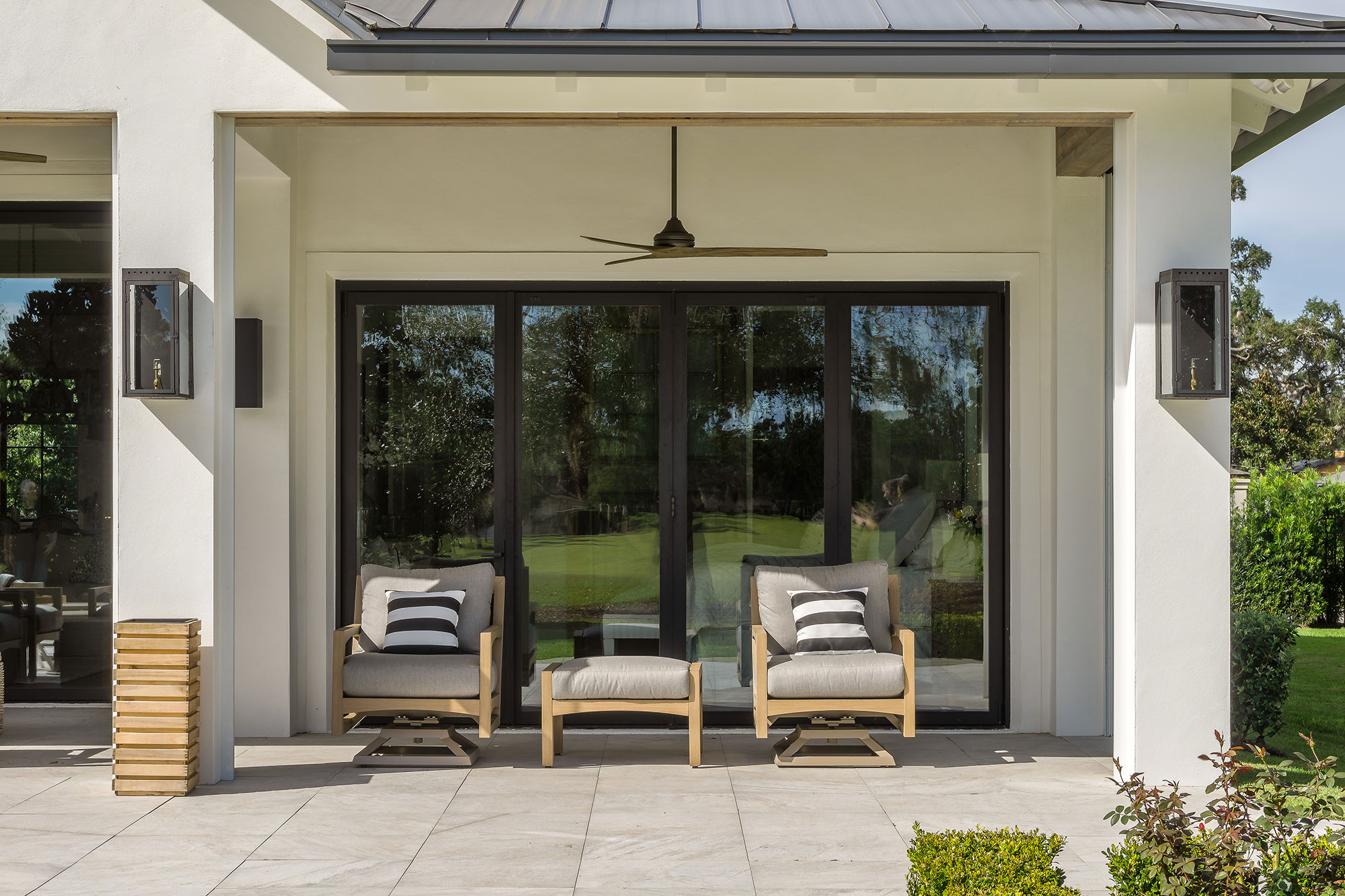
Photo courtesy of LaCantina
Expansive glass panels and sleek designs are a coveted feature in any home design.
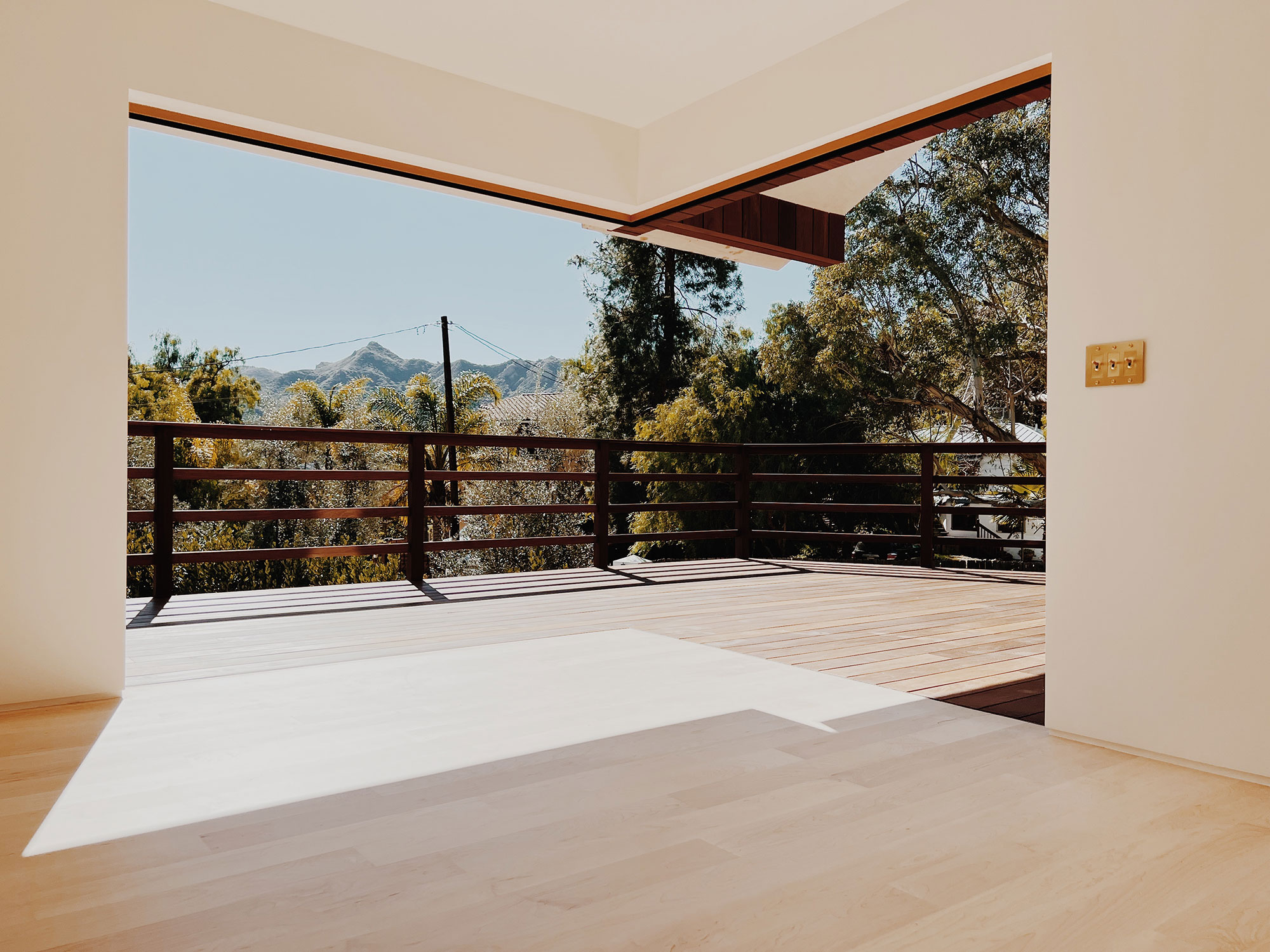
Photo courtesy of LaCantina
"With flexible configurations, zero post corners, integrated screening solutions and hurricane-rated options, our forward-thinking and creative nature allows us to offer unique, functional and high-performing door systems,” said Tim Kelting, Senior Director of Product Line Management, LaCantina.
Translating Market Forces into Residential Design Trends
Rose Quint, assistant vice president for survey research at NAHB, reports that homeowners are demonstrating a desire for smaller homes, a fact directly linked to poor housing affordability.2 In addition to shrinking overall footprints, buyers are compromising with smaller lots and the compression or combination of rooms inside a home.
As an adaption to this constriction in space, home designs are evolving to become more flexible, offering multipurpose spaces. “Flex rooms offer the perfect opportunity to combine hobbies and daily routines to carve out spaces that encourage both,” notes Yvonne Harbison of Build with Ferguson.3 Creating task zones and selecting dual-purpose furniture allow rooms to perform double duty. However, part of this flexibility also includes designing features that can alter boundaries and walls in order to create more malleable spaces. The residential use of partitions and large sliding or folding doors, which can collapse and expand space as needed, is on the rise. Large door openings deliver a key to allowing transformation. Movable glass door systems effortlessly add or remove walls to change the configuration of a space. This strategy also brings in more fresh air and enhances views, improving homeowner health and wellness.
While the size of homes has shrunk, the percentage of glass in doors and windows has grown. Not only are wider glass panels a popular design feature, but frames have also grown narrower. Homeowners increasingly request broader, clearer views of the outdoors and plenty of natural light. In response, glass with minimal framing is central to modern residential design. The narrower the frame around each glass panel, the less noticeable the window or door is, compared to the beautiful view beyond.
Unique, personalized touches are being used to mark a home as crafted, rather than produced. Features incorporate custom pieces throughout a design–from doors to countertops to furniture to travel souvenirs. Builders are employing unique storage solutions, using vertical space, and making almost everything, from appliances to rooms, multi-use. This additionally allows home design solutions to focus on maximizing the space available.4
While not a brand-new trend, design professionals continue to discover and create new uses for these spaces, as well as outfit them for year-round enjoyment. Outdoor living and the use of the exterior of the home and its surroundings to create new living spaces is paramount. “People are recognizing that the backyard has long been under-utilized square footage,” writes D Magazine. “In the quest to make every inch of property useful and livable, indoor spaces are opening directly to the backyard or to patios with pizza ovens and fire pits.”5 Product innovations are following suit, aimed at providing flexible, all-season open spaces that create seamless connections and enhance the beauty of the built environment. The sense of merging living spaces and of moving effortlessly between ceiling and sky, between enclosure and limitlessness, defines livability as luxury.
Movable Glass Panel Door Systems: Capturing Design Flexibility
By their very design, movable glass or multi-panel door systems enable effortless engagement between the interior and outdoors. A movable glass door system is a door or window system with multiple operable panels that open sequentially to create an opening exceeding traditional limitations (see sidebar Sliding or Folding? Details to Consider for full details on operation types). Reaching beyond the capability of a hinged patio door, multi-panel systems transition between indoors and out. The wide and seamless opening they furnish blends nature right into any home, eliminating any perceived divide.
Windows and doors are also playing a crucial role in modernizing design, helping set the up-to-date home apart from its traditional counterpart. A Contemporary Craftsman stands out on the street because of its bold incorporation of windows along the front facade; an American Farmhouse style might feature a pivot entry door system greater than 6 feet wide and a multi-panel zero-post corner system. A tiny ADU is dominated by a large facade composed of glass sliding doors. Today’s leading designs are, at their core, glass-centric. To modernize a fenestration package, narrow frames, stiles, and rails are necessary. In style, frame elements should be minimized, with square lines, rather than traditional bevels.
Hardware has undergone a similar reformation. Locks and handles are combined into a seamless, simplified, single system, removing unnecessary visual clutter from doors and windows. Door sills are completely recessed, avoiding the creation of a defining line between rooms or spaces.
Contemporary design is also changing window framing materials. While all-aluminum windows and doors were once a budget-driven, lower-grade window, thin-frame all-aluminum window and door packages with high performance values are currently in demand to capture a more up-to-date feel in homes. Metal finishes, whether aluminum, clad, or anodized, dominate the current palette. Regardless of framing material selected–wood, clad, or metal–thinner frames with simplified details define the trend.
Unique window and door configurations more commonly seen in commercial spaces are also being embraced for residential purposes, as smaller homes capitalize on both space and distinctive design. Their translation from commercial into residential is changing the face of homes. Massive multi-slide and folding door systems are a hallmark of the trend, but beyond this staple is also an increased use of doors with zero post corners. Additionally, folding or multi-slide windows that combine directly into a multiple-panel door system, without a post, are gaining in popularity.
Transforming any Lifestyle with Movable Glass Panel Doors
Large expanses of glass constantly bring in additional daylight and vibrant outdoor views of land and sky. Expansive openings transform the entire experience of indoor-outdoor living, creating a boundless feeling. Small spaces should not confine people in the ways they live, work, and play. Any time architects can bring a sense of boundlessness to indoor spaces, those spaces live larger. Moveable glass panel door systems and full view glass doors offer a tool to achieve precisely that vision.

Photo by Kendall McCaugherty; courtesy of LaCantina
Movable glass panel doors are not simply a design focal point, they also play a pivotal role in connecting people to wellness and nature.
ENHANCING LIFE
The modern home should not just be livable, it should enhance the lifestyle and health of its occupants. The best design does not have to feel torn between these goals; rather it can facilitate the cooperation of these elements through new products and layouts.
Incorporating Health from the Outside in with Movable Glass Panel Door Systems
Movable glass panel door systems not only open design opportunities by erasing the border between inside and out, they also enhance the health of any structure, regardless of size.
IAQ
Indoor air quality (IAQ) is a critical aspect of sustainable, holistic design. The term IAQ refers to the air quality within and around buildings and structures, especially as it relates to the health and comfort of building occupants. While pollution of outdoor air is a recognized concern, common pollutants can also accumulate indoors, creating the risk of health concerns inside. As home envelopes and duct systems are built tighter to save energy and meet increasingly stringent codes, these tighter systems are more likely to trap contaminants indoors. Studies from the EPA on human exposure to air pollutants show that indoor levels of pollutants may be two to five times greater, and sometimes even more than 100 times higher, than outdoor levels.6 To compound the issue, people now spend almost 90 percent of their day indoors–65 percent of that in their homes.7
There are three basic strategies for improving indoor air quality, as recommended by the EPA: source control, improved ventilation, and air cleaners.8 The introduction of outdoor air is central to promoting better air quality. Increasing the amount of outdoor air coming indoors lowers the concentrations of indoor air pollutants in the home.
Using movable glass panel door systems opens areas that would otherwise be confined by walls. This aids in whole-house air circulation, bringing clean and fresh air into the structure and replacing existing, stale air. Larger openings allow for greater natural ventilation and establish a broader ventilation pathway. They are also very effective in ventilating smaller interiors. By removing the divide between interior and exterior living spaces, multiple panel systems also draw occupants outside more frequently.
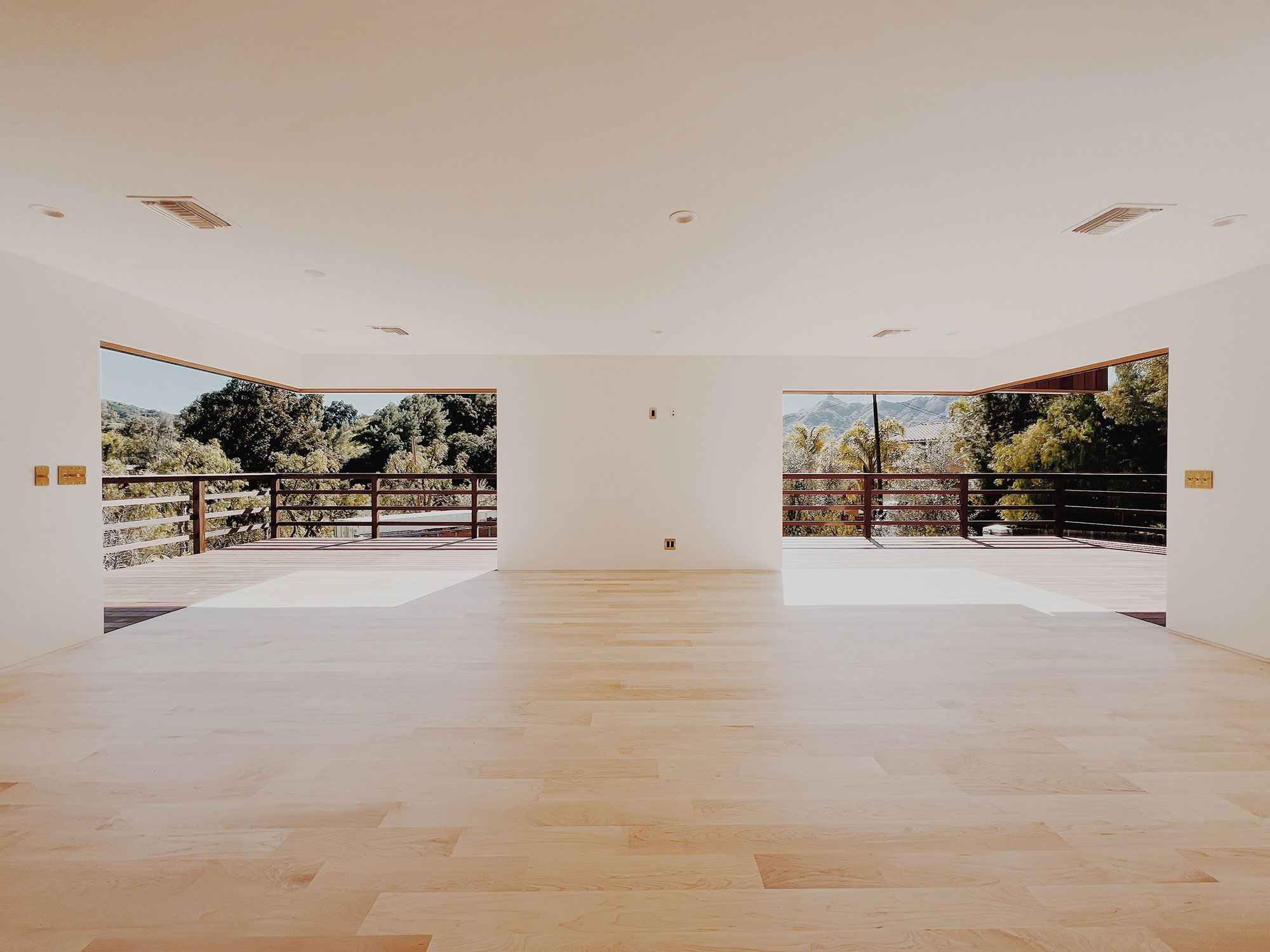
Photo by Mason St. Peter; courtesy of LaCantina
Disappearing pocket doors connect interior and exterior spaces, with two corners transformed into zero post pocket systems.
Natural Light
Just as expansive openings create better ventilation, the increased use of glass in movable glass panel door systems allows for greater natural light transmittance. As knowledge about the relationship between light and health increases, the importance of daylighting to human welfare is being prioritized. Daylighting has been associated with improved mood, enhanced morale, less fatigue, and reduced eyestrain.9 “Design can play a key role in improving the health and well-being of the public,” notes Kyle Konis, Ph.D, AIA, and Director of the Chase L. Leavitt Building Science Program.10 Konis pioneered research to develop a daylighting metric and design assist tool capable of assessing the circadian effectiveness of architectural space.11 For Konis, areas within a building that do not achieve lighting conditions necessary for effective circadian stimulus can be labeled as biologically dark and considered problematic for health and well-being.12
By replacing an entire traditional wall with glass, multi-panel systems can maximize the provision of beneficial light to the interior. Introducing daylighting into interior spaces has proven positive health implications, from reducing headaches induced by artificial light to diminishing the symptoms of people affected by seasonal affective disorders (SAD). Bringing natural light to the interior of a building also allows for passive solar heat gain and minimizes the use of electricity in artificial lighting.
Movable glass panel doors used in a design harness additional holistic advantages for a project. Because the innovative design of movable glass panel door systems connects both indoors and out, the system maximizes any space to define a boundless living experience. Using products that are domestic contributes to green design goals by minimizing fuel and transportation costs normally associated by importing products from areas outside of the United States. Certain manufacturers also pack and ship systems using recycled materials, providing safe transport and smart use of renewable resources.
ENHANCING PERFORMANCE
The expansive use of glass makes any home a beautiful, welcoming, and modern space. It also places heavy performance demands on that glass and the surrounding frames. As a greater percentage of wall space is occupied by windows and doors in smaller homes, the insulative and performance properties of those products need to be increased, to avoid placing an energy burden on the building. The entire system must also be evaluated on its ability to prevent air leakage, how it will interact with weather events, and how it will stand up to the wear and tear of daily use. This is where energy and performance codes become invaluable. Understanding the certifications for door performance means selecting with confidence a movable glass system that will not only look beautiful but will perform beautifully over the life of the building.
In tandem with the improved health metrics that movable glass panel door systems can provide, enhancements in manufacturing and technology have increased efficiency. Today, these systems can occupy a greater area in the building envelope without compromising overall performance.
Thermal Performance
Classifying and labeling the real thermal performance of door and window systems is the focus of The National Fenestration Rating Council (NFRC), a not-for-profit trade association. NFRC 100 “Procedures for Determining Fenestration Product U-factors” is the accepted standard for rating windows, doors, and skylights for U-factor.
A U-factor is typically rated between 0.20 and 1.20. This standard establishes standardized environmental conditions, product sizes, and testing requirements, so that architects and others can make informed choices fairly and accurately by comparing the performance of different products.
NFRC testing also looks at other overall performance characteristics, including the solar heat gain coefficient (SHGC), which measures how much solar energy passes through a particular glazing, creating heat gains inside a building. A SHGC is expressed as a number between 0 and 1. In areas where heat gains are a concern, coatings are applied to the glass to allow less transference.
NFRC testing additionally assigns a value to the visible light transmittance (VT). Values are between 0 and 1. VT determines the effective light available for daylighting, helping gauge potential offset of electricity costs for lighting a building’s interiors.
U-factor, SHGC, VT, and air leakage (AL) are all disclosed on an NFRC label for an individual product. The lower the U-factor, the better the insulation level of the unit, meaning less loss of heat to the outside. A low SHGC number means more solar energy will be blocked, eliminating passive heat gain from outside into the building. The higher the VT, the more natural light is transmitted through a product.
A typical high-performance door will have a U-factor of 0.32 or less and an SHGC of 0.30 or less, depending on climate zone.
Air, Water, and Structural Performance
In addition to thermal performance, codes and standards, including those of the NFRC, have increasingly recognized air leakage (AL) as a very significant factor in fenestration performance. Today’s window and door products must meet minimum standards for air infiltration, and be tested, certified, and labeled for this performance. The total system must be able to withstand wind pressures associated with its geographic location, and air leakage must be controlled not only for energy performance but also for occupant comfort and long-term durability of the fenestration system. NFRC expresses AL as a number ranging between 0.1 and 0.3. A higher AL means greater air infiltration over the life of the product. The most suitable AL rating for an energy-efficient building will be at or near 0.1.
Better manufacturers may also offer testing that reaches beyond air infiltration and measures air exfiltration. Certain product categories may require exfiltration testing and certification, per the NAFS-08, or North American Fenestration Standard/Specification.
Each potential system should have an American Architectural Manufacturers Association (AAMA) Product Performance Class as well as a minimum Design Pressure (DP) rating. ASTM E-547 tests water penetration of movable glass panel door systems, with air infiltration testing via ASTM E-283 criteria.
The structural integrity of a multiple-panel door system ensures that it will perform correctly over its lifetime. High structural integrity in door units allows the system to maintain proper fit and operation of the products under conditions of wind, rain, and other weather stresses. Structural Load Deflection testing is typically measured under ASTM E-330 and should be reported by the manufacturer. This test is used for standard doors as well movable glass panel door systems, with the results directly dependent on the size of the panels.
For commercial applications, or residential applications seeking commercial ratings, AAMA publishes the primary standard for commercial windows and doors in its document AAMA/WDMA/CSA 101/I.S.2/A440-08, “North American Fenestration Standard (NAFS)/Specification for windows, doors, and skylights.” This standard defines four (4) different Product Performance Classes: R, LC, CW, and AW. It also identifies the minimum Performance Grade (PG) that is required to satisfy the criteria of each class. The defining criteria is the minimum design pressure (DP) that a unit must resist such that class R must withstand 15 pounds per square foot (psf) of pressure, class LC 25 psf, class CW 30 psf, and class AW 40 psf.
In addition, each class must meet minimum water resistance test pressures ranging from 2.9 psf for Class R, 3.75 for Class LC, 4.50 for Class CW, and 8.0 for Class AW. ASTM E-547 tests water penetration. The specified sill configuration routinely has a direct influence on the results. The ability of the door as an entire system to either seal water out completely or to manage water, so that any water penetrating the system drains away, is analyzed under ASTM E-547. As an example, multi-slide glass doors have been tested using these ratings and standards and have been found to meet overall DP ratings of up to 45 with additional structural up to 90 psf and no water leakage at up to 6.8 psf.
Impact probability also is classified as high, moderate, or low. Doors subject to high impact are often the very same doors with a high frequency of use, but not always. Referring to ANSI/SDI A250.8 may be helpful in guiding selection.
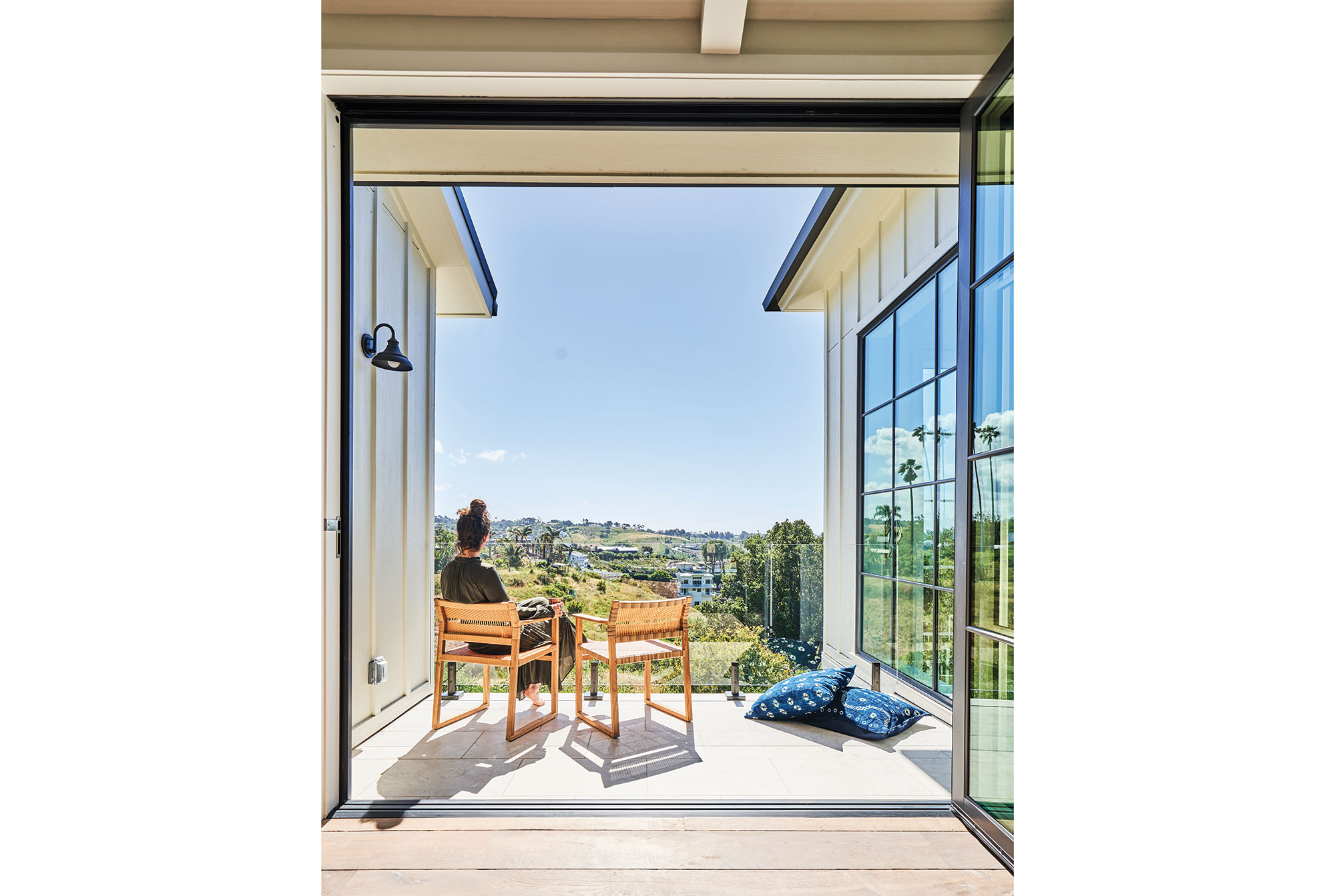
Photo: Thomas J. Story; © 2024 Sunset Publishing Corporation
It is a misconception that doors cannot be efficient. Modern designs have evolved to incorporate advanced materials and technology to enhance energy efficiency. Features like low-emissivity (low-E) glass, multiple panes, and enhanced insulation have become standard, ensuring that today's patio doors have the highest levels of style and performance.
Enriching Sustainability
Movable glass panel door systems can enhance efficiency by selecting energy-efficient glass, glazing features, and thermally improved frames. Leading manufacturers offer doors with dual-paned tempered glass as a standard, creating an insulating barrier between the inside and out. Advanced low-e glass options are available to help reduce cooling costs in the summer and heating costs in the winter.

Photo courtesy of LaCantina
Innovations in multiple panel doors ensure reliability and performance even in challenging weather conditions.
Critical to sustainability are the enhancements to interior environmental quality provided through increased daylighting and fresh air ventilation. Movable glass panel door systems open areas typically blocked by walls to aid in whole-house air circulation, bringing clean and fresh air into the home. Allowing for more glass and light, multiple panel door systems offer a good passive heat source and minimize use of electricity for daytime lighting.
If wood or clad door systems are under consideration, certain manufacturers offer FSC®-certified wood. The Forest Stewardship Council (FSC) sets forth principles, criteria, and standards to guide forest management and practices toward sustainable forestry worldwide. FSC certifiers verify that companies claiming to sell FSC-certified products have tracked their supply back to FSC-certified sources. This chain of custody certification assures that consumers can trust the FSC label.
Movable glass panel door systems can help to earn a U.S. Green Building Council Leadership in Energy and Environmental Design (LEED) designation for their projects. Architects and project owners can submit many of these characteristics for point consideration within their project.
Possible LEED Opportunities:
- Energy & Atmosphere Prerequisite 2
- Energy & Atmosphere Credit 1
- Materials & Resources credit 2
- Indoor Environment Quality Credit 4.4
- Indoor Environment Quality 6.2
- Indoor Environment Quality 8.1
- Indoor Environment Quality 8.2
Manufacturer Testing and Certification
The best manufacturers create movable glass panel door systems that are not only visually appealing but also are built to perform, even in the most severe climates and regions. Door systems should be developed, designed, tested, and engineered for optimal thermal performance, structural integrity, strength, and protection against the elements.
For additional confidence when specifying products, manufacturers themselves can gain certification. The National Accreditation & Management Institute, Inc. (NAMI) has established product testing and quality assurance validation programs. NAMI certifications offer global certification and quality assurance designations. They specialize in fenestration and building envelope products, which include, but are not limited to windows, doors, and glazing wall systems.

Photo courtesy of LaCantina
Large patio doors may raise concerns about insect intrusion, especially in certain climates. Modern movable glass panel door systems come equipped with screen options that keep bugs at bay while allowing fresh air to circulate.
ENHANCING OPTIONS
Movable glass panel door systems offer the ideal solution to create a boundless living experience for any home. These door systems, both folding and multi-slide, are available in a variety of materials and have multiple hardware options. Selection of system specifications should consider use, aesthetics, climate zone, and efficiency goals.
Frame Materials
Aluminum
Aluminum systems have a clean, modern aesthetic. Contemporary appeal is enhanced by an optional narrow 2- ¾ inch stile and rail profile, allowing for maximum glass and light. Aluminum is suitable for use in exterior applications or as interior space dividers. A 10-inch-tall bottom rail and low-rise sill meet commercial Americans with Disabilities Act (ADA) requirements. Aluminum frames are offered in several finish options. Anodized white, clear, and dark bronze aluminum rails and stiles match most commercial aluminum window finishes. Selecting aluminum eliminates the need for finishing and offers low maintenance. Aluminum typically has the poorest U-factor and is best suited for use in moderate climates, where heat loss is not a concern.
Aluminum Thermally Controlled
This aluminum system offers improved thermal performance suitable for climates where temperature fluctuations can impact the conditioned interior space and where higher resistance to water and air infiltration is required. Featuring non-conducting thermal breaks throughout and narrow stile and rail profiles, aluminum thermally controlled systems are designed for optimal energy efficiency and structural performance that minimizes condensation build-up and heat-cold transfer. European thermal struts create a non-conductive bridge between the outside and the inside of the door. Thicker panels (2-15/16 inches) are suitable for high wind environments and, when specified, can include impact-rated features. Split finish color options for the interior and exterior provide maximum design flexibility.
Aluminum Wood
Better suited to exterior environments than a solid wood door, an aluminum wood system offers a low-maintenance aluminum exterior with a natural wood interior. The hybrid panel construction typically consists of a 1-¾-inch-thick extruded aluminum and ½-inch solid wood interior. Typically, several wood species options are offered. Common options are vertical grain Douglas fir, alder, and mahogany. The exterior aluminum surface can be powder coated to a range of colors or finished to duplicate an all-wood look. An engineered aluminum panel construction creates strength and rigidity for panels over 8 feet tall.
Clad Systems
Made using heavy gauge extruded aluminum cladding as the exterior, in combination with a solid laminated wood core construction and a natural wood interior facing, clad systems offer greater durability, efficiency, and ability to withstand the elements. Clad systems typically have the best U-factor, offering maximum energy efficiency in colder climates. New, contemporary cladding systems use consistent-width narrow stile and rails, a square profile design, and standard anodized finishes combined. Contemporary clad complements more modern architectural styles and window packages.
Wood
Best for interior space dividers, or exterior applications shielded from weather, all wood systems lend a distinctive architectural style to a space. Usually available in a range of wood species, wood finishes may be prepped for custom finishing on site or fully finished in factory. The wood surface does require sealing, staining, or painting. Standard wood systems incorporate a 3-⅝-inch stile and rail profile, with 7- ½-inch and 10-inch bottom rail options and can accommodate custom panels from 1- ¾ inches to 2- ¼ inches thick. Most manufacturers use a solid laminated veneer lumber (LVL) wood core construction to maintain the integrity of the frame. Wood can provide energy efficiency and good thermal performance. When FSC-certified wood is used, the system can earn the project green credits.
Vinyl
Vinyl offers excellent performance in all environments, and is an ideal solution for renovations, offering a match with popular residential vinyl window packages. This material captures a lower price point while still allowing for a modern, expansive door opening. Energy-efficient, high-quality vinyl systems perform well in all environments and offer a budget-friendly solution for home renovations and new construction. Narrow 2 15/16” stile and rail profile, allowing more glass and light, are highly compatible with contemporary design. No finishing is required and vinyl offers a low-maintenance finish.
Thresholds and Components
Sills or thresholds need to be coordinated and should support both the door system and number of door panels. Thresholds should also be selected based on weather exposure and floor transition.
Thresholds are available in at least three different profiles and should be specified according to the project design needs. Fully recessed thresholds are an ideal application to create seamless blending between spaces. Flush sills are designed to be recessed into the floor, creating a level transition between the finished interior floor surface and the exterior. Flush sills can incorporate the same finish flooring between the sill tracks. Flush sills offer seamless transitions and are a preferred solution for covered openings. While recessed thresholds used to suffer from poor weather performance, new sills allow for full recession at or below the finish level. For areas with open weather exposure, weather resistant weeping tracks allow for the recessed sub sill to capture and drain water away from the building via tubes. Three different leg heights allow for performance in moderate to extreme weather conditions.
Raised sills are intended to have a raised profile and sit up above the exterior. Depending on the manufacturer, raised sills come in varying interior leg heights. Raised sills offer a greater degree of weather resistance. Raised sills, or special weather-resistant sills, are the preferred solution for weather-exposed openings. Ramped sills are commercially compatible and offer ADA compliance when there is more than a ½-inch change in the sill height compared to the walking surface. All threshold styles are typically thermally broken.
The grade of material for the threshold should be specified, as well as the bearings, hinges, and wheels of the door panels. Nylon plastic and stainless steel are the most commonly seen materials. Stainless steel components usually offer the best durability and longevity for large or heavy door panels.
To control air leakage and improve energy efficiency, Multi Panel Door systems also rely on a mix of perimeter seals applied to each door panel. Top seals can be brush type to allow for the smooth operation of the door while still restricting the transfer of air and weather. The bottom or sill seal may be composed of low-friction coated rubber applied to the bottom of the door, creating a full seal yet allowing for the smooth operation of the door panels. Continuous seals along the edges of each door panel may be compression rubber gaskets, fin brush seals, or both. Careful application of high-grade seals provides a tight seal when the doors are closed and helps to maintain pressure and weather resistance.
Superior manufacturers will offer AAMA certification and cycle testing, demonstrating the sustainability of their hardware and components over time. This allows for greater confidence in design decisions.
Screens
Larger door openings also require larger screens, where desired, designed specifically to complement large openings. For multiple-panel systems, a fully retractable screen that is only seen when in use can be seamlessly integrated into the system. Door systems may incorporate single screens or double screens (coming from opposite sides) depending on the width of the opening. Double screens at angles accommodate applications such as zero post corners.
Integrated pleated and non-pleated screening solutions help protect the interior from insects or debris, and act as an added filter, when necessary, between occupants and the outdoors. A pleated mesh screen system offers the best protection against insects, leaves, and twigs blowing in. The pleated construction makes the screen material more stable, as it resists sagging, and keeps it compact, helping it collapse neatly to one side when not in use. It is also the most cost-effective solution. Non-pleated screens provide excellent levels of transparency, allowing for uncompromised views.
Movable glass panel door systems with a blind option deliver complete privacy and, in warm climates with direct solar exposure, improved energy efficiency by deflecting harmful UV rays and reducing heat transfer.
In partnership with their focal aesthetic role, advancements in movable glass panel door systems and component technology allow any design to achieve energy efficiency goals, performance, and service life, creating a project that transcends trends.
SOURCES
- “Home-Buyer Preferences Shift as Affordability Challenges Remain.” National Association of Home Builders®. April 1, 2024. https://www.nahb.org/news-and-economics/press-releases/2024/04/home-buyer-preferences-shift-as-affordability-challenges-remain. Accessed May 21, 2024.
- Quint, Rose. “Top Compromises Buyers Will Make to Reach Homeownership.” National Association of Home Builders®. May 13, 2024. https://eyeonhousing.org/2024/05/top-compromises-buyers-will-make-to-reach-homeownership/. Accessed May 21, 2024.
- Harbison, Yvonne. “6 Go-To Multipurpose Room Ideas.” Build with Ferguson. https://www.build.com/multipurpose-room-ideas/a25897#:~:text=These%20areas%20could%20mean%20simply,how%20to%20use%20the%20space. Accessed May 23, 2024.
- Salaky, Kristin. “Home Trends Are Embracing Small Spaces – Here’s How to Maximize Your Square Footage.” Forbes Home. April 1, 2024. https://www.forbes.com/home-improvement/design/tips-for-decorating-small-homes/. Accessed May 21, 2024.
- Kostelny, Laura. “The Latest Trends in Home Construction and Renovation.” D Magazine. January 8, 2014. https://www.dmagazine.com/publications/d-home/2014/january-february/latest-trends-in-home-construction-and-renovation/. Accessed May 22, 2024.
- “Indoor Air Quality Backgrounder: The Basics.” U.S. Environmental Protection Agency. https://www.epa.gov/sites/default/files/2015-09/documents/backgrounder.pdf. Accessed May 23, 2024.
- “Are concerns about indoor air quality making it difficult for you to breathe easy in your own home?” ASHRAE®. https://www.ashrae.org/technical-resources/free-resources/10-tips-for-home-indoor-air-quality#:~:text=As%20homes%20and%20duct%20systems,of%20that%20in%20their%20homes. Accessed May 23, 2024.
- “Improving Indoor Air Quality.” United States Environmental Protection Agency. June 27, 2023. https://www.epa.gov/indoor-air-quality-iaq/improving-indoor-air-quality. Accessed May 23, 2024.
- Robbins, C. L. (1986) Daylighting Design and Analysis, New York: Van Nostrand Reinhold Company.
- “Kyle Konis Receives 2016 AIA Award.” USC Architecture. May 19, 2017. https://arch.usc.edu/news/kyle-konis-receives-2016-aia-upjohn-award. Accessed May 23, 2024.
- Konis, Kyle. “A novel circadian daylight metric for building design and evaluation.” Building and Environment. November 14, 2016. http://dx.doi.org/10.1016/j.buildenv.2016.11.025. Accessed May 23, 2024.
- “Kyle Konis Receives 2016 AIA Award.” USC Architecture. May 19, 2017. https://arch.usc.edu/news/kyle-konis-receives-2016-aia-upjohn-award. Accessed May 23, 2024.
Amanda Voss, MPP is an author, editor, and policy analyst. Writing for multiple publications, she has also served as the managing editor for Energy Design Update.
LaCantina is a pioneer in designing and manufacturing large opening door systems. Our focus in developing and refining these products has resulted in the most innovative and comprehensive range of folding, sliding and swing doors available to enhance indoor outdoor living.
Originally published in Architectural Record
Originally published in August 2024
LEARNING OBJECTIVES
- Describe how market trends are influencing residential design and creating new opportunities for movable glass panel door systems.
- Analyze how glass panel door systems can enhance occupant welfare and health, including enhancing indoor environmental quality.
- Identify the performance testing and certifications required for doors and explain how they measure product performance and sustainability.
- Explain how component improvements and innovations have enhanced design choices while enabling greater energy efficiency and performance from movable glass panel door systems.


